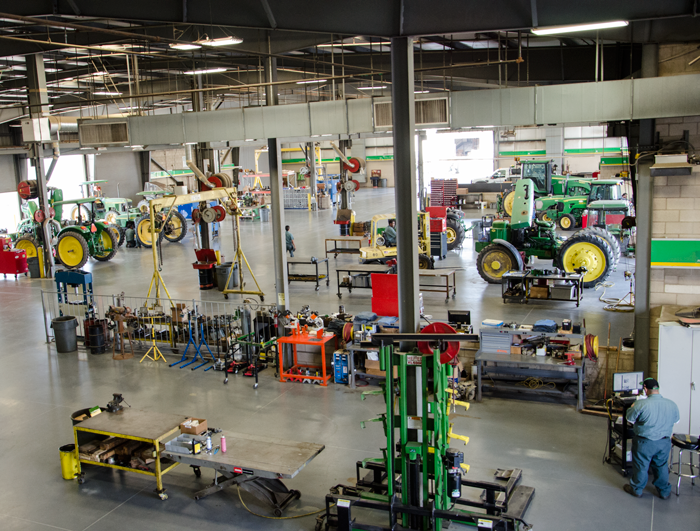Quality service, not low prices, builds customer loyalty, and customer loyalty means return business. That’s what every dealership needs to shoot for.
The service department is the backbone of the dealership and if it isn’t working efficiently or priced correctly, the entire dealership will suffer. On the other hand, if it’s running properly, it can be one of the most profitable parts of the dealership and loyal customers are the result.
Bob Clements, president of Bob Clements Int’l. and management consultant for outdoor power, agriculture and power sports equipment dealers, says that while many dealers believe the service department is a static thing that never changes, it should be viewed as a living, breathing organism.
“We’re always learning. There are always new things coming up. Customers shift and change, manufacturers change and you have to constantly be working with the service department to maximize the profit you get out of it,” he says.
Focus on Quality
The first step to maximizing the profitability of the service department is to set expectations. Clements says the number one goal for any service department needs to be that you do what you say you’re going to do, when you say you’re going to do it.
Dealer Takeaways
Customers care less about the cost and more about having a job done right the first time. Don’t be afraid to charge more for high quality service.
Flat rate prices for service should be determined by the equipment’s condition. Don’t make the mistake of charging a single flat rate for all equipment.
The service department’s recovery rate is a strong indicator whether the shop needs more or fewer technicians.
Satisfied customers can be turned into loyal customers through high quality service that offers a unique experience they won’t find elsewhere.
“When work comes into the shop, I expect us to be the ultimate professionals,” he says. “I expect it to be on time and on budget. If I tell a customer I’m going to have a piece of equipment back to them by this time, come hell or high water I’m going to do everything in my ability to make that happen.”
Being able to execute service professionally, on time and on budget requires a service team that works together. Clements says it’s absolutely necessary to isolate any employees who aren’t doing their share and cut them loose sooner rather than later.
“Everyone in the service department has to grab an oar and pull their weight. We can’t have just one person pulling the oar for everyone. Your dealership is a warship and you probably have one or two people who are sitting out behind the boat on an inner tube complaining that the people in front aren’t rowing fast enough. Cut them loose now,” Clements says.
Customers care less about the cost of service as long as it’s right the first time, Clements adds. Dealers should aspire to be known for the quality of their service work, not cheap prices.
Forging Loyal Customers
For top quality service, Clements says dealers need to charge more and can expect to lose a few customers at first who don’t want to pay the higher prices. But dealers can also expect to gain more customers because of the quality of work they’re putting out.
“For every job dealers do, they should build in time for a final quality inspection at the end before giving the machine back to the customer. We never tell customers upfront that we’re building it in, but when we price it out, we make sure it says this amount of time was put toward a final quality inspection to make sure everything is right,” he says. “Don’t worry if some customers complain about the price as long as you’re doing the work professionally and getting it done right the first time. I want customers to say, ‘ABC Dealership doesn’t have the lowest prices, but if you want it done right, that’s where you take it.’”

Bob Clements, dealer management consultant and president of Bob Clements Int’l., says only 15% of customers care enough about price to stop going to a dealership when they raise their rates.
According to Clements, only about 15% of a dealer’s customer base will care enough about getting the lowest price to stop coming to the dealership. He sites this example, “I was at a dealership and was trying to get them to push their labor rate up, but they were concerned that people would just quit doing business with them if they raised their rates. This dealer had 3 people in one day complain about pricing. They had 40 customers that day, so by the 15% rule, statistically they should have had about 6 people complain about the price, which tells me they should raise their rates.
“There’s always going to be someone out there who is charging half your rates, but we’re not looking for the customers who only want the cheapest price. We don’t care about that 15% of the customer base. Dealers need to build their business around the other 85% through high quality service,” he says.
Clements adds that for most dealerships, 25% of the customer base is made up of loyal customers who the dealership has developed a strong relationship with over time. These are the customers who don’t mind what the dealership charges and will stick with the dealership through thick and thin. Another 60% of dealers’ customer base is made up of the existing and future customers who do business with a dealership based upon their satisfaction with the quality of work the dealership does. “These satisfied customers will leave you if they think they can be more satisfied somewhere else,” he says.
While many dealers focus on satisfying customers, Clements says they should be focusing on turning already satisfied customers into loyal customers. This requires service departments to deliver quality service, but also give customers an experience they won’t find elsewhere.
“People are willing to pay for uniqueness,” Clements says. A service department that wants to earn loyal customers has to go above and beyond what normal, good service departments do.
“If I go into a shop and it’s messy and dirty and disorganized and they say, ‘We’ll get to you as soon as we can,’ they’re like every other shop out there. Successful service departments create uniqueness.”
Clements says creating uniqueness involves more than having friendly, well-trained technicians. A unique service department is clean and organized, allows customers to request service through the dealership website or sends out texts and emails to keep customers up to date on how their service is coming along and when it will be done. (See the sidebar on mobile technology for the service department.)
Setting Profitable Rates
About 75-80% of the work coming through the service department should be flat rated, Clements says. The flat rate can be determined by using the manufacturer’s warranty rate guide and adding on a percentage, depending on the condition of the equipment. He says many dealers make the mistake of not accounting for the equipment’s condition and only charging a single flat rate for all work.
Clements uses three levels of equipment condition when determining the flat rate:
- Excellent to good condition (nearly new): charge the warranty rate
- Good to fair condition (mild to moderate corrosion with the shoulders still present on most bolts): add 50% to the warranty rate
- Fair to poor condition (heavily abused): add an additional 40% to the “good to fair condition” flat rate
For work that isn’t assigned a flat rate, Clements says dealers can determine what to charge for the hourly or labor rate by researching what area car and truck dealerships are charging.
“Don’t call around to all of the competitive farm equipment dealers and ask what they’re charging,” he says. “We call that ‘pooling ignorance’ because then you’re all just charging the same rate. Instead, base it on what the local car and truck dealers are charging in their shops. Ford and Chevy and the other auto manufacturers spend a lot of time and money researching what to charge in a certain area, so we don’t have to go back and reinvent the wheel. Charge a little bit less than what they’re charging and you’ll be in good shape.”
Satisfied customers will leave you if they think they can be more satisfied somewhere else...
Once the flat rate and labor rate have been determined, Clements recommends adding on additional fees for shop supplies and oil and waste handling. The shop supply fee helps offset the cost of consumables and upgrades to shop equipment. He says many of the shops he works with charge 5% of the labor as a shop supply fee.
This money should be set aside for when the shop needs money for new equipment. “Many dealers take this money and zero it out at the end of the year and add it to revenue, but that’s really not what it’s meant for,” he says. “The account should be carried through year-over-year so the service manager can use that money to help pay for things being used in the shop.”
Clements also suggests charging an environmental fee on the work that comes through the shop to take care of oil and waste handling costs and to maintain the shop wash area. Not all states currently have environmental standards for dealers to manage oil and waste handling or wash area maintenance, but Clements says its coming down the line and dealers will need money to manage those costs in the near future. He says many of the dealers he works with charge about $2-3 per work order as an environmental fee.
Mobile Technologies Increase Technician Efficiency
The last 5-10 years have seen leaps and bounds in mobile technology that is making nearly every aspect of our lives easier. Tom Barnes, solutions manager with CDK Global Heavy Equipment, explains how mobile solutions are increasing efficiency in dealership service departments.
Measuring Success in Service
The service department sells time, not labor hours, Clements says. If there are three service technicians in the shop working 8 hours a day, then the service manager has 24 hours of time that they’re responsible for selling every day. He breaks each hour of time down into 10 segments of 6 minutes. It’s the service manager’s job to make sure that all of those segments are sold every day.
“Unlike parts or wholegoods, if we don’t sell all of our service time segments in a day, we can’t keep them sitting on the shelf and try to sell them again tomorrow. They’re gone,” Clements says.
At the end of each day, he says service department managers should do a labor analysis report to see how many of the day’s time segments were sold. “I expect service managers to be accountable for every segment and I expect every time segment every day to be sold,” he says. “If not all of the time segments are being sold, you need to find a way to get more work in the shop or you need to reduce the number of technicians you have.”
The next step is to establish each service technician’s efficiency, also referred to as wrench efficiency. “If a tech is on a job for 2 hours and the service department bills for 2 hours of work, then that technician has 100% efficiency,” Clements explains. “Most technicians, though, are only at about 50-60% efficiency and that kills the profitability of the service department.”
Most technicians are only at 50-60% efficiency and that kills the profitability of the service department...
B-level technicians should be billing a minimum of 100% of their time and A-level techs should be working at 115% efficiency. If the technicians aren’t able to get the job done in the time allocated, Clements says this is a sign that the work wasn’t priced correctly and the flat rates being charged need to be adjusted.
The recovery rate is also an important metric to consider when looking for ways to improve shop profitability. The recovery rate is measured by how many hours a tech is in the shop vs. how much time is being billed. Clements says that for many service departments, 70% is the average recovery rate, but to be profitable, dealerships need to be hitting at least an 85% recovery rate, meaning they’re billing at least 6 hours of the technician’s total 8 hours in the shop each day.
Clements uses the recovery rate as an indicator for whether the shop needs more or fewer service technicians. “If you’re recovering at 106%, that’s a sign that the shop needs another technician,” he says. “But, adding an additional technician to a shop that’s recovering at less than 85% is a bad idea because you already have so much capacity that you’re not using with the technicians you have. Adding another technician will just drive the recovery rate down from there”
Compensating Your Techs
Service technician compensation programs should reinforce the processes in place in the service department and reward performance.
From the moment equipment enters the shop to the moment it leaves, Clements says the service department needs to have a documented, step-by-step process for everything that happens to that equipment. “If at any point something breaks down, you can then go back to the process and find where something fell apart,” he says.
Processes help increase repeatability, which Clements says leads to increased profitability. “The more repeatable a job or process is, the less skilled a person needs to be to do it.
Watch Bob Clements’ webinar
“Building a High Performance Service Department,” for more service department management best practices.
Once the processes are in place, a compensation program can be created to reinforce the processes. “In dealerships I work with, the process is set up so that B-level technicians should be at a minimum of 85% efficiency on any work order they put their hands on,” Clements says. “We pay all of our technicians an hourly rate. Let’s say I pay a technician $15 per hour and my effective labor rate is $80 per hour. I could pay 30% of that $80 out to a technician who is 100% efficient, which would be $24 per hour.
“For technicians who are 85-100% efficient, I give them a $2 bonus per hour on top of their $15 per hour. If the technician is 101-125% efficient, I give them a $4 bonus per hour on top of their $15 per hour,” he says.
It all comes back to quality work. If a technician has even one customer return because the problem wasn’t fixed or the technician did a repair incorrectly, the technician loses their bonuses for that 2 week period.
“Trust me, they only lose that bonus once and then you don’t have to worry about the quality of work coming out of the shop,” Clements says. “I’m willing to pay good money, but we have to put out good work.”








Post a comment
Report Abusive Comment